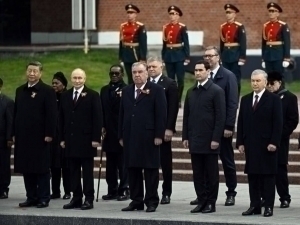Trillions of Investments in Uzbekistan: Where are They Making an Impact?
Interviews
−
24 May 2023 18178 4 minutes
Investment in Uzbekistan has experienced a steady increase, reaching astonishing figures in recent years. According to the Statistics Agency, investments in the country's capital alone amounted to an impressive 42 trillion soms in the fist quarter of 2021. Projections indicate that this number will exceed 50 trillion soms by January-March 2022. The upward trend continues in 2023, with a substantial investment of 56.6 trillion soms in just three months. However, a pressing question arises: where is all this money going, and why are tangible improvements in people's lives not being seen?
During the 32nd annual meeting of the Board of Directors of the European Bank for Reconstruction and Development (EBRD) in Samarkand from the 16th to 18th of May, QALAMPIR.UZ had the opportunity to address this question to Abudlla Abdukadirov, a renowned economist and CEO of the Strategic Reforms Agency.
Abdukadirov clarified, "The majority of the investments mentioned are primarily focused on maintaining and upgrading existing infrastructure. Consequently, these investments often go unnoticed by the population. People are acutely aware of problems when there is a shortage of gas, electricity, or water. However, when these services are readily available, they tend to take them for granted. Significant investments are required to sustain the status quo. With the growing population and expanding economy, increased investment becomes necessary. Most of the funds allocated to infrastructure come from the state, as it may not be a priority for foreign banks or entrepreneurs to provide water to remote regions of Uzbekistan, or construct roads. Therefore, the state bears the primary responsibility for investments. Although not immediately apparent to the general public, these investments do exist if one delves deeper into the matter."
He emphasized that the current priority for the state is to achieve and maintain energy independence. Consequently, a considerable portion of investments is directed towards the development of solar and wind energy across the country. However, the share of solar and wind power plants in Uzbekistan's overall energy system remains relatively small, accounting for only 10% of total electricity generation. Natural gas continues to be the main energy resource, posing significant challenges during the winter season.
The EBRD has actively engaged in financing the energy sector, as demonstrated by several contracts signed during the 32nd annual meeting in Samarkand. Notably, a wind power plant in Nukus received a substantial allocation of $19 million, while a total of 3.6 trillion soms was earmarked for the energy sector as a whole. These investments contribute significantly to the impressive figures previously mentioned. However, concerns have been raised due to the lack of noticeable improvements in people's lives, particularly during the harsh winter months.
Abdukadirov, offering valuable insights, stated, "We would be mistaken to expect a miraculous transformation in the energy sector that solves all problems at once. These issues have accumulated over time, particularly in gas extraction. We must address the challenge of supplying both electricity and gas to settlements across Uzbekistan. Therefore, we need to make a decision regarding the direction we choose. Prioritizing electricity makes transportation and distribution easier, allowing people to utilize it for lighting, heating, cooking, and entertainment. Hence, our focus should be on implementing programs that provide electricity to remote villages, even if it takes five or ten years."
Nevertheless, Abdukadirov believes that expanding gas extraction remains crucial, necessitating the allocation of substantial funds for geological research by the state. He emphasized, "Geological exploration is currently underway in Ustyurt at altitudes exceeding 6,000 meters above sea level. We have hopes of discovering significant deposits there. However, this is not a matter that can be resolved within one or two years. A single descent to a depth of 6,000 meters takes up to five months. Our first priority is to identify where to dig."
While the EBRD aims to reduce the state's share in Uzbekistan's economy and promote market competition, state-owned enterprises still comprise a significant portion of the country's business landscape. This raises the question of whether the EBRD has established specific requirements for the privatization of state-owned enterprises in Uzbekistan.
For further insights and answers to these questions, please watch the video interview available on QALAMPIR.UZ's YouTube page, where additional information is provided.
Live
All07 January




